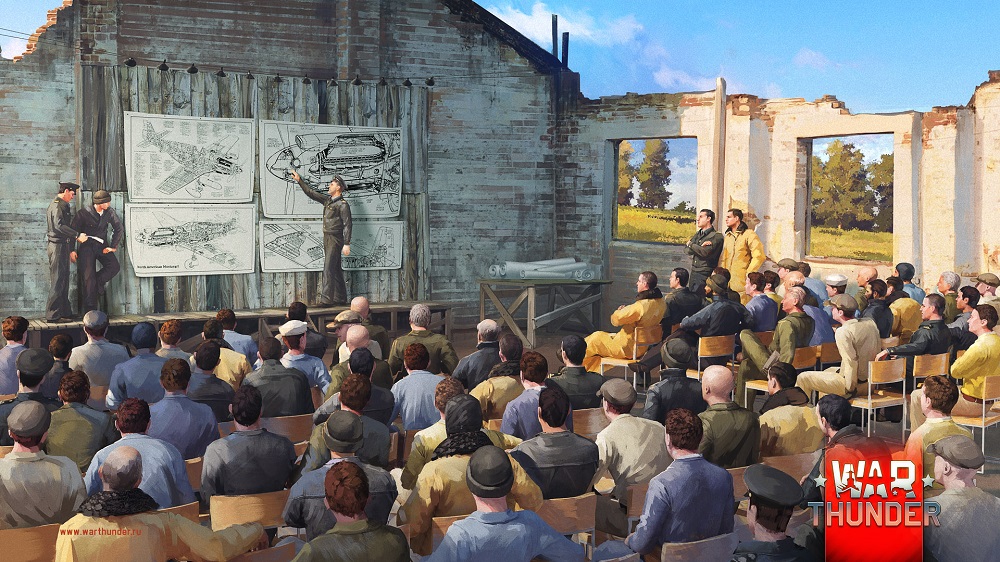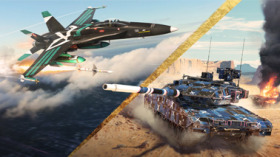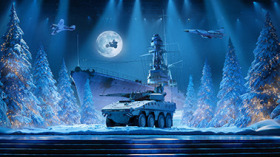
- For PC
- For MAC
- For Linux
- OS: Windows 10 (64 bit)
- Processor: Dual-Core 2.2 GHz
- Memory: 4GB
- Video Card: DirectX 11 level video card: AMD Radeon 77XX / NVIDIA GeForce GTX 660. The minimum supported resolution for the game is 720p.
- Network: Broadband Internet connection
- Hard Drive: 22.1 GB (Minimal client)
- OS: Windows 10/11 (64 bit)
- Processor: Intel Core i5 or Ryzen 5 3600 and better
- Memory: 16 GB and more
- Video Card: DirectX 11 level video card or higher and drivers: Nvidia GeForce 1060 and higher, Radeon RX 570 and higher
- Network: Broadband Internet connection
- Hard Drive: 62.2 GB (Full client)
- OS: Mac OS Big Sur 11.0 or newer
- Processor: Core i5, minimum 2.2GHz (Intel Xeon is not supported)
- Memory: 6 GB
- Video Card: Intel Iris Pro 5200 (Mac), or analog from AMD/Nvidia for Mac. Minimum supported resolution for the game is 720p with Metal support.
- Network: Broadband Internet connection
- Hard Drive: 22.1 GB (Minimal client)
- OS: Mac OS Big Sur 11.0 or newer
- Processor: Core i7 (Intel Xeon is not supported)
- Memory: 8 GB
- Video Card: Radeon Vega II or higher with Metal support.
- Network: Broadband Internet connection
- Hard Drive: 62.2 GB (Full client)
- OS: Most modern 64bit Linux distributions
- Processor: Dual-Core 2.4 GHz
- Memory: 4 GB
- Video Card: NVIDIA 660 with latest proprietary drivers (not older than 6 months) / similar AMD with latest proprietary drivers (not older than 6 months; the minimum supported resolution for the game is 720p) with Vulkan support.
- Network: Broadband Internet connection
- Hard Drive: 22.1 GB (Minimal client)
- OS: Ubuntu 20.04 64bit
- Processor: Intel Core i7
- Memory: 16 GB
- Video Card: NVIDIA 1060 with latest proprietary drivers (not older than 6 months) / similar AMD (Radeon RX 570) with latest proprietary drivers (not older than 6 months) with Vulkan support.
- Network: Broadband Internet connection
- Hard Drive: 62.2 GB (Full client)

Dear Players
Today, we wanted to share some more insight and answers on the recent penetration mechanic changes to explain our plans, goals and some more on your specific questions.
When planning the move to a new method of penetration calculation we set ourselves following goals:
- To make the penetration calculation system open and understandable, in which the method is known and the data for the calculations are known clearly to all. In the old calculation system each shell received its penetration data manually from a variety of sources, ranging from authoritative monographs to documents on firing tests. At the same time, in many of these sources the penetration data was also calculated according to different methods and different standards of states, different targets and with different hardness of armour and shells used. Therefore, uniformity and standardization were out of the question and accordingly it was not the best option in terms of openness and ease of understanding.
- To get rid of the discrepancies that arise from the use of many different sources. When considering data from sources, inconsistencies arise due to different standards and criteria. The problem immediately arises in the reference source - which document is the correct document? However, the sources in question are documentary and credible. The situation is - all are equal, but some of them are more equal. Again, as you can see, this was not the best option.
- Focus the attention when setting up armour-piercing on their input parameters - mass, speed and speed drop tables. If you have a shooting table for the shell, you can more accurately model its behavior and, first of all, its penetration. We will not stop working with documented sources. We collect information scattered over hundreds of conflicting sources and concentrate it on firing tables and ammunition ballistics settings.
- To streamline the armour-piercing system in the game. Manual entry of penetration data, from sources, in some cases created situations where the data in the shell cards were from documents in which the penetration data were based on very different criteria. Which is not the norm. With the increase in the number of vehicles in the game, and therefore the number of ammunition, the sources of information regarding the penetration values are beginning to exceed reasonable limits, and some documents are not publicly available and could no longer be open and easy to understand.
We definitely have not stopped working with documented sources. The specified method of calculation is to work with documents first of all, and more purposefully and effectively, allowing us to specify not only the penetration data, but also ballistics of shells, thus allowing us to standardize all this information in game.
Now, lets move on to the Q & A:
Q.Will primary source material if it contradicts the calculated performance, still be taken into any consideration for the newly calculated APFSDS rounds? For example, Swedish tests show vertical performance of DM33 and it is substantially higher than calculated values.
A. In the calculation we used the density of tungsten cores equal to 17500 kg/m^3 (indicated in the published table sheet with changes). This corresponds to the 2nd class of tungsten alloy from the specification. The choice of this density value has been made due to the fact that the exact density values at the moment are unknown for us. In this case if reliable and unambiguous (based on documents, shooting reports, etc.) information about the density of cores is provided, we are ready to clarify it for the appropriate ammunition. Until such data is available we are fully satisfied with the current data scores for the ammunition.
Q. If there are armour values on tanks that are based on what rounds can and cannot penetrate them (both by design specification and performance in combat), will we see armour changes where appropriate?.
A. No, such changes would contradict the goals we set when developing this method. There are no plans to introduce an additional indicator of the quality of the armour, except for what is already in the game.
Q. Will the Demarre equation that is being used be fixed? A fair amount of apcbc rounds would be over performing (much higher than historic data) if we used the current calculation from the wiki.
A. By choosing the method we knew that there would be some discrepancies, both in the smaller and in the larger direction. And after the evaluation of possible negatives and positives we decided that the general level of changes in values is comfortable for us by not exceeding the level of conditionality that had already been before. It makes many more improvements and last but not least it reveals the method of penetration calculation for everyone and makes it clear. Therefore, there are no plans to make any corrections to the calculation aimed at "fitting" the data to various sources.
Q. The Slope modifier equations from World War 2 Ballistics: Armor and Gunnery, were designed to work with the vertical penetration values from the book. Changing these values while also changing the vertical penetration of many projectiles, many lower, and some higher, will cause issues. How is this going to be handled?
A. We do not want and will not allow situations that violate the integrity of the selected calculation method. Using the calculated values of slopes together with the old method of choosing armour-piercing will be just such a situation.
Q. The DeMarre formula relies on an empirically derived constant. This constant differs based on armour-projectile combination. How do you plan to determine this constant given the vast array of armour and projectile types in the game?
A. Earlier in the game as previously indicated the penetration values were given for armour of low hardness. The constant for the calculation has been chosen so as to also correspond to this armour. This value is 1900 and corresponds to the homogeneous armour of low hardness.
Q. Does standardizing penetration performance of ammunition also allow for standardizing secondary fragmentation for ammunition? Right now all rounds that utilize the 'long_rod' shatter preset create less fragmentation than rounds with less weight, thickness and velocity. This is also noticable on APDS, where an APDS round with a comparable penetrator diameter to an AP round creates much less fragments.
A. The applied calculation method of armour-piercing data acquisition is not connected with secondary fragments configuration. This problem is known and will be corrected.
Q. Will ricochet angles for long rod penetrators receive a change? Pre change they are a fixed angle across many different shells with different velocities and tip designs, the target material is also not taken into account when in reality this has a big effect and can change the ricochet angle by a great deal.
A. Revision of ricochet values for APFSDS shells was not planned in the near future. If and when the reliable information will be provided to improve and refine the ricochet parameters (if necessary) for these shells, it will be considered in the usual order.
The War Thunder Team




Comments (121)
dumb question i believe USA and GB are the only countries that use depleted uranium sabot rounds in there tanks how will that be reflected? as an aside how can you create challenger 2 armour values when NOONE knows about Chobham
they'll tell you after people have brought golden eagles to unlock the tanks
What about the fact that the equation for APFSDS penetration can't be used for the Russians since they don't use long rod APFSDS? Russian tanks received a very minor nerf if one at all, while the M1 Abrams now has 120mm less penetration than the AMX-40? The M1 Abrams could already have had M833 without having anywhere NEAR the penetration of the Type 90, but now it's pen is worse than a premium a full BR lower, and only 57mm more than the T59E1 at 8.0.
These changes all make sense, however, I believe a comprehensive approach is necessary here. BR adjustments need to be real and substantial. Some bullets just need to go away (M69 and M72 for example) and some new rounds may be in order (M833 for maybe the M1IP as an example). You did things like this with the 10.5 CM Tiger II, (getting rid of it's original stock round) and the low level Japanese (adding HEAT rounds as standard). This equation makes sense, but good playability needs fixed.
Overall M774 got nerfed, both at 0 and 30 degrees angle with a little buff at 60 degrees. Are you planning to add M883 for Abrams especially after adding new top tier tanks in next patch? Thanks
i'm okay with that and DM33 for the 2A4 since the DM23 is equally useless
Asgar1205, It woudn't be OP with new formula. Would be around 120 DM23 performance. Altough it's DU so it should do more post pen damage.
With the addition of very modern vehicles, new shells are possible. Do you plan to implement PELE rounds with proper post-pen damage modeled?
Can you guys fix the Fw190 C gun placement first? its such trvial bug the still havent fixed yet
DM13 and DM23 sucks! Created for Smashing Tanks like the T-64s. Unfortunately I can only show you evidence in German. German military engineering engineer proves that the T-64, T-80 and T-72 had no protection against the RHM 120mm L44. (Dipl. Ing. Rolf Hilmes)watch youtube "Ingame APFSDS post-pen performance" page 6 in War Thunder Forum All evidence are given. So Gaijin why we don't get a corrected penetration and dmg model? The performance of the Rhm 120mm L44 far higher. Why so satisfied?
IS-7 has 294mm of pen at 500 meters and it's at 8.0 and the Maus has only 213mm on the stock shell at 500 meters and is 7.7 and the shell you research is 267mm at 10 meters and 252mm at 500 meters. Very balanced comrade ))))) nothing wrong here.
the Maus is extremely slow
Will Yugoslavia ever make it into the game? Has a valid number of planes.
the game was much better off without this change, id rather have historical data on osomething then get this unballanced crap in my game, especialy when half the calculations are utterly wrong and ignore important data points
Submit a complaint